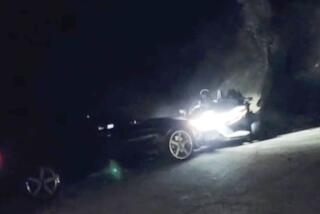CHP Directs Safety Message at Black Drivers
Concerned that black motorists are disproportionately represented in fatal car accidents, the California Highway Patrol is preparing to launch a $2-million campaign aimed a increasing seat belt use and decreasing drunk driving among African Americans.
The campaign idea was prompted by previous studies that show African Americans are less likely to wear seat belts and slightly more likely to be victims of deadly alcohol-related accidents than whites.
But African American activists worry that the CHP may be sending the wrong message by targeting blacks. They note that the agency has been sued by the American Civil Liberties Union, which has charged that officers stop blacks and Latinos as much as three times as often as white motorists.
“I can’t imagine it will go over big in the African American community,” said Geraldine Washington, president of the Los Angeles chapter of the National Assn. for the Advancement of Colored People. “The tone of that could be very negative.”
She suggested that the CHP instead reach out to all ethnic groups with a general traffic safety campaign.
CHP officials say they are sensitive to fears about stereotyping, particularly over use of alcohol.
For that reason, the agency plans to meet with African American representatives throughout the state next month. It expects to begin the campaign, with billboard, radio and newspaper ads, in February.
CHP Commissioner D.O. “Spike” Helmick said he believes that the campaign can be effective without bringing protests.
“We want to reach out and understand the best method to get out to that community,” Helmick said. “Our intent is to put a helping hand out.”
The campaign will not be the CHP’s first to target a minority group. In 1987, the agency introduced “El Protector,” a similar safety campaign that employs Spanish-language officers and brochures to emphasize traffic safety among Latinos.
Mothers Against Drunk Driving struggled with the same sensitivity concerns when it started a campaign last year to educate Latinos about the dangers of drinking and driving.
MADD is about to kick off a similar campaign in New Mexico, targeting Native Americans.
“I commend the CHP, because they are doing the same thing we are trying to do,” said Tina Pasco, executive director of MADD’s Los Angeles chapter.
Although traffic fatalities have declined steadily for years, the CHP reported that the number of African Americans killed in car accidents in California has increased slightly, from 191 in 1999 to 198 in 2000.
Nationwide, Native Americans have the greatest risk of dying in car crashes, followed by African Americans, Latinos, whites and Asians, according to a 1994 federal study.
An analysis by the National Highway Traffic Safety Administration of accidents from 1990 to 1994 showed that 68% of all deadly crashes involving Native Americans had been alcohol-related. The rate was 55% for Mexican Americans, 45% for African Americans, 44% for whites and 28% for Asians.
CHP officials believe that a major factor in the African American death rate is the low rate of seat belt use among black motorists--51% nationwide, compared with 63% for whites, according to the federal traffic safety agency.
A federally funded study released in 1998 found that African American youths are half as likely to buckle up as white or Latino youths.
The disparity is the result of a lack of traffic safety programs in the African American community, according to a federal panel that studied the problem in 2000. The panel found that nearly half of blacks surveyed believed that seat belts were just as likely to harm them as to protect them.
Also troubling is a 5% increase last year in the number of alcohol-related crashes statewide, according to the CHP.
Charles Andrews, assistant director of the Alabama Department of Public Safety and a member of the National Organization of Black Law Enforcement Executives, said he supports the CHP’s efforts.
He noted that Alabama launched a similar seat belt campaign for African Americans in 2000. He said the program helped increase seat belt use from 52% to 79% among all motorists in that state.
Andrews also commended the CHP for seeking the advice of black representatives before kicking off the campaign, saying such guidance might help avoid misunderstandings and conflicts.
“That is what we did,” Andrews said. “We were trying to let people know upfront that the goal was to save lives.”
More to Read
Sign up for Essential California
The most important California stories and recommendations in your inbox every morning.
You may occasionally receive promotional content from the Los Angeles Times.











